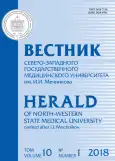Возможности КТ-перфузии в диагностике новообразований поджелудочной железы
- Авторы: Кабанов М.Ю.1, Семенцов К.В.1, Беликова М.Я.2, Яковлева Д.М.1
-
Учреждения:
- Северо-Западный государственный медицинский университет им. И.И. Мечникова
- Госпиталь для ветеранов войн
- Выпуск: Том 10, № 1 (2018)
- Страницы: 89-94
- Раздел: Научный обзор
- URL: https://journal-vniispk.ru/vszgmu/article/view/8819
- DOI: https://doi.org/10.17816/mechnikov201810189-94
- ID: 8819
Цитировать
Полный текст
Аннотация
В статье приводится клиническое наблюдение, когда при УЗИ и стандартном протоколе МСКТ с применением внутривенного болюсного контрастирования и методики многофазного сканирования не удалось выявить опухоль головки поджелудочной железы и оценить ее резектабельность. Включение в протокол исследования КТ-перфузии поджелудочной железы позволило четко визуализировать и локализовать опухоль, оценить ее размеры, взаимоотношения с магистральными сосудами. По результатам обследования была выполнена операция панкреатодуоденальной резекции.
Полный текст
Открыть статью на сайте журналаОб авторах
М. Ю. Кабанов
Северо-Западный государственный медицинский университет им. И.И. Мечникова
Автор, ответственный за переписку.
Email: konstantinsementsov@gmail.com
Россия, Санкт-Петербург
К. В. Семенцов
Северо-Западный государственный медицинский университет им. И.И. Мечникова
Email: konstantinsementsov@gmail.com
Россия, Санкт-Петербург
М. Я. Беликова
Госпиталь для ветеранов войн
Email: konstantinsementsov@gmail.com
Россия, Санкт-Петербург
Д. М. Яковлева
Северо-Западный государственный медицинский университет им. И.И. Мечникова
Email: konstantinsementsov@gmail.com
Россия, Санкт-Петербург
Список литературы
- Нестеров Д.В., Розенгауз Е.В. Динамическая компьютерная томография у больных раком поджелудочной железы. Оценка перфузии в опухоли и в паренхиме железы вне ее // Медицинская визуализация. – 2014. – № 2. – С. 68–74. [Nesterov DV, Rozengauz EV. Dynamic Computed Tomography at Patients with Pancreatic Cancer. Perfusion Analysis in the Tumor and Pancreatic Parenchyma. Medical Visualization. 2014;(2):68-74. (In Russ.)]
- Нестерюк Я.И. КТ-перфузия при опухолях поджелудочной железы // Медицинская визуализация. – 2015. – № 3. – С. 57–67. [Nerestyuk YaI. CT Perfusion of Pancreatic Tumors. Medical Visualization. 2015;(3):57-67. (In Russ.)]
- Долгушин М.Б., Тулин П.Е., Оджарова А.А., и др. КТ-перфузия в дифференциальной диагностике опухолей печени // Медицинская визуализация. – 2015. – № 5. – С. 18–31. [Dolgushin MB, Tulin PE, Odzharova AA, et al. KT-perfuzija v differencial’noj diagnostike opuholej pecheni. Medical Visualization. 2015;(5):18-31. (In Russ.)]
- Кармазановский Г.Г. Опухоли поджелудочной железы солидной структуры: протоколы лучевых исследований, дифференциальная диагностика // Медицинская визуализация. – 2016. – № 4. – С. 54–63. [Karmazanovsky GG. Solid Pancreatic Tumors: Protocols of Radiological Examinations and Differential. Medical Visualization. 2016;(4):54-63. (In Russ.)]
- Xie Q, Tang Y, Tang Y, et al. Whole-Organ CT Perfusion of the pancreas: Impact of Iterative Reconstruction on Image Quality, Perfusion Parameters and Radiation Dose in 256-Slice CT-Preliminary Findings. PLoS ONE. 2013;8(11):1-8. doi: 10.1371/journal.pone.0080468.
Дополнительные файлы













